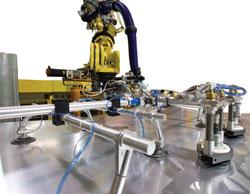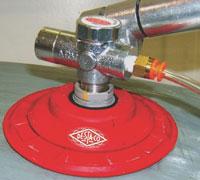Senior Industry Marketing, Program Manager
- FMA
- The Fabricator
- FABTECH
- Canadian Metalworking
Categories
- Additive Manufacturing
- Aluminum Welding
- Arc Welding
- Assembly and Joining
- Automation and Robotics
- Bending and Forming
- Consumables
- Cutting and Weld Prep
- Electric Vehicles
- En Español
- Finishing
- Hydroforming
- Laser Cutting
- Laser Welding
- Machining
- Manufacturing Software
- Materials Handling
- Metals/Materials
- Oxyfuel Cutting
- Plasma Cutting
- Power Tools
- Punching and Other Holemaking
- Roll Forming
- Safety
- Sawing
- Shearing
- Shop Management
- Testing and Measuring
- Tube and Pipe Fabrication
- Tube and Pipe Production
- Waterjet Cutting
Industry Directory
Webcasts
Podcasts
FAB 40
Advertise
Subscribe
Account Login
Search
New tools pick up material handling pace
Improved, flexible technologies move parts through presses faster with less damage
- By Peter Stephan
- April 27, 2012
- Article
- Materials Handling

A tool-changing system with no-touch locking technology allows air, input/output, and power to be coupled to tooling that is unique for each part being handled.
Adaptive handling of formed parts is possible using tooling techniques developed to support the increasing number of robots handling parts to and from each set of presses.
Robots have been used in the pressroom for nearly 20 years and have gained popularity because of their flexibility and ability to handle various parts in different press layouts. Over the years robots have evolved from spot welders into fast and agile machines for material handling. Tooling has also evolved, adapting to ever-changing needs.
Another major progression has occurred at the desk of the engineer who now can simulate a full automation line, tooling, part path, and throughput optimization. This type of simulation can greatly reduce the risks inherent in die development.
Picking up Speed
Quick-change tooling now allows robots to move from one end effector to another in a matter of seconds.
Quick change of factory tooling increasingly can be accomplished with a tool changer that is coupled and uncoupled quickly and automatically. Before the start of a new production run, tools are staged near the robot to allow for automatic tool exchanges. The automatic tool changer comprises a master side plate attached to the robot and tool side plates attached to individual tools.
Some locking, rigid, and repeatable tool changers use a no-touch locking technology in which air, input/output (DeviceNet, Profinet, Profibus, Ethernet, Interbus, and discrete), and in some cases power, can be coupled to the tooling that is unique for the part being handled. On the tool side, the same elements are prewired and plumbed so that any tool that is attached will function correctly through the robot control.
A camera mounted to the robot helps to determine the precise location of the tooling quickly. In many facilities changing the tools by hand during die change has been eliminated and replaced by prestaging before the next production run.
A Firm Grasp
Changes have taken place in end-effector design, too, enabling robots to pick up hard-to-handle materials.
Steel and aluminum are now the principal materials in end effectors. Steel has become thinner, and in some cases stronger with heat treatment. Aluminum is becoming more popular because it is lightweight, but it is soft, so an aluminum end effector must be handled with care.
Hygiene can also be a material handling concern. Vacuum systems are most commonly used to pick parts that must remain clean throughout the metal forming, punching, and flanging processes. The vacuum systems are self-cleaning, and materials that contact the parts have been changed to avoid the collection and distribution of contaminants from part to part.

The master side of the tool changer mounts to a robot or other structure, offering tool change flexibility.
Vacuum cups handle many different part types. They are available for destacking; handling parts with flat, mild, or high contours; and surfaces that are slick or dry.
Current vacuum-generation systems are located at the cup that contacts the part. Only one air line is required to draw the part to the tool, blow the part off, and place it on the die.
Tools typically are assembled using a master mount from the faceplate of the robot or tool changer, often called a world tool. Other branches of the tool are assembled to the master mount, which allows the components of each branch to be light enough for one person to handle. While production is running, the toolmaker can assemble the next set.
An Eye on Placement
Vision systems are used primarily to ensure proper part orientation at the front of the line and the placement of parts into and out of racks before and after the subassembly process. These systems have not been readily applied to examine every part for quality control. Part producers know that to avoid making bad parts in the first place, they need to use consistent materials, clean the materials before the first forming operation, maintain the dies, and ensure that the robotic handling system causes no damage.
Dies now can be scanned for surface features exhibiting wear characteristics after a production run to help determine if and where repairs are needed. Collecting data from the die after making consecutive quality parts allows a duplication of setup conditions when the dies are used again to produce the next batch with the same specifications.
Added Articulation
Advancements in robotic articulation have enhanced the use of automation in press tending.
Many different robots in use today handle parts from small and large presses. The most common element of each application is a six-axis robot with a wrist that allows the articulation of the part into and out of the die. It is the articulation that gives the designer the flexibility to build a fairly complex die. The more complex the die, the fewer hits are needed to make the part.
Some of today’s fast material handling robots are outfitted with a seventh axis to quickly pull the part, once off the die, into and out of the die cavity. One robot was specifically developed to handle parts from press to press. It has a long body through the lengths of the links of axis two and three, and a wrist to handle long offsets from the faceplate that is typical of a tool used to capture parts.
Automated Programming, Design
Programming for robots has become easier and faster. Operators and skilled tradespeople are no longer required to determine the best way to handle the parts.
In the past a worker used the teach pendant to enter or copy the logic, taught the paths, and optimized the throughput by watching the line run. Today the specifications for dies, parts, and robots are uploaded as models into the virtual world. Dies are created with 3-D CAD systems, and parts can be imported into a virtual cell of the system.

An end effector with two mating parts, a master side (left) and tool side (right), is designed to automatically lock together and pass utilities such as electrical signals, pneumatics, and water.
A tool can take this information and allow the system developer to provide a complete program before the dies are set. Programs are uploaded to the robot controls from the engineering office, in some cases via Ethernet. This allows the operators to determine virtually that the programmed paths and device functions are correct before production begins. Program adjustments are identified, corrected, and verified, and that information is sent back to the system engineer for archiving and future use.
Continual Transformation
Producers of formed metal parts have a great deal to anticipate. Automation using robots will become smarter, faster, and even more accurate. Changeovers will take less time with the use of tool changers and tool stands. Components that handle parts will be more robust to enable handling of parts safely and cleanly time and time again.
Transformation in metal forming material handling continues.
About the Author
Peter Stephan
3900 W. Hamlin Road
Rochester Hills, MI 48309
248-377-7000
Related Companies
subscribe now

The Fabricator is North America's leading magazine for the metal forming and fabricating industry. The magazine delivers the news, technical articles, and case histories that enable fabricators to do their jobs more efficiently. The Fabricator has served the industry since 1970.
start your free subscription- Stay connected from anywhere

Easily access valuable industry resources now with full access to the digital edition of The Fabricator.

Easily access valuable industry resources now with full access to the digital edition of The Welder.

Easily access valuable industry resources now with full access to the digital edition of The Tube and Pipe Journal.
- Podcasting
- Podcast:
- The Fabricator Podcast
- Published:
- 04/30/2024
- Running Time:
- 53:00
Seth Feldman of Iowa-based Wertzbaugher Services joins The Fabricator Podcast to offer his take as a Gen Zer...
- Industry Events
Pipe and Tube Conference
- May 21 - 22, 2024
- Omaha, NE
World-Class Roll Forming Workshop
- June 5 - 6, 2024
- Louisville, KY
Advanced Laser Application Workshop
- June 25 - 27, 2024
- Novi, MI
Precision Press Brake Certificate Course
- July 31 - August 1, 2024
- Elgin,
































